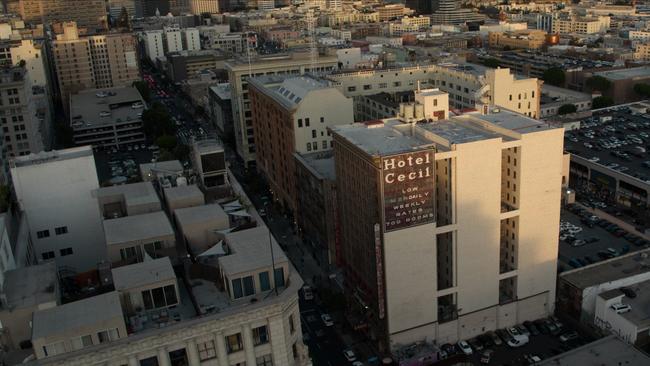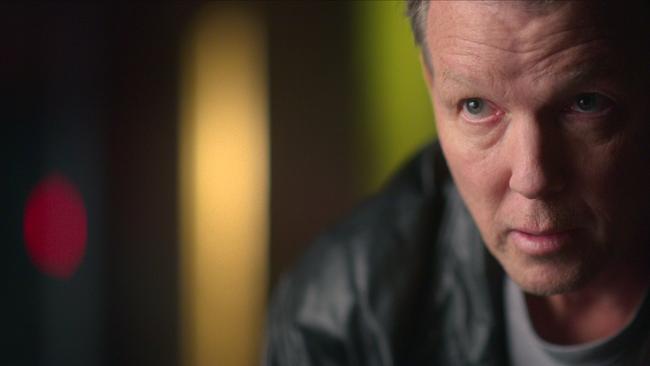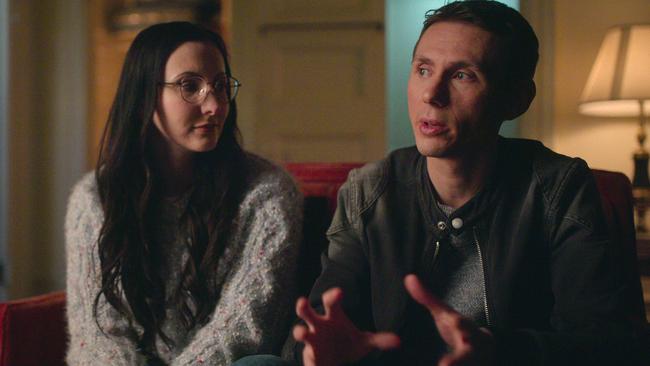Dark history unveiled Netflix’s Crime Scene: The Vanishing at the Cecil Hotel
A true crime series focusing on events at notorious locations immerses viewers in the lurid past of a once boomtown LA establishment dubbed Hotel Death.

Crime Scene: The Vanishing at the Cecil Hotel is the first it seems of what Netflix has projected as an anthology series that investigates a crime or multiple misdemeanors that have occurred at notorious locations across the decades.
It’s a potentially fertile idea for a true crime series: as any devout reader of police procedurals knows, a crime scene may include any type of building, a person’s body, vehicles, and places in the open air or objects found at those locations. And successful this four-part series is, too, having debuted a fortnight ago in the No. 1 spot for the international streamer.
It’s directed by Oscar-nominated, Emmy-winning documentary filmmaker Joe Berlinger (Cold Blooded: The Clutter Family Murders), who rather like a crime-scene investigator systematically examines the Hotel Cecil in the first season. Once a boomtown establishment when it opened in 1924, it’s now somewhat impoverished and located in the middle of notorious Skid Row in downtown Los Angeles, a trap for unwary tourists.
Berlinger questions its role in the disappearance and possible murder of Eilsa Lam, a mystery that still elicits more questions than answers. A four-minute video of Lam’s last sighting in the hotel’s elevator moments before her vanishing amassing tens of millions of internet views.
She was a 21-year-old Canadian student who disappeared in 2013 at the Cecil while she was travelling alone across the US on a getaway trip from her studies at the University of British Columbia in Vancouver, her home town.
Was she the victim of some horrible, evil presence in the Cecil, aka “Hotel Death”, that took control of her as many of the countless so-called “web sleuths” thought at the time, as they convulsively worked to find answers to the mystery at the same time as the LA police? Or was the disappearance something less conspiratorial?

There are plenty of conspiracies and coincidences examined by Berlinger in the series as, in his parallel investigation, he uses his own form of deductive and inductive reasoning to gain knowledge of the events surrounding the crime. And in doing so he immerses us in both the mystery and the noirish life of the Cecil Hotel, dropping us into its creepy atmosphere and giving us a viscerally immediate experience.
“I thought it would be interesting to examine the history of the place where the crime took place, and all the socioeconomic forces that contribute to why certain places become a nexus for crime or the perception of crime,” the director told Kimberley Ricci at website Uproxx. “So, we pitched Netflix the idea of not simply covering the story but the idea of focusing upon specific locations, in which a lot of crime has happened and in a way to turn the true crime genre on its head a little bit.”
It’s an original production for Netflix, which is increasingly enthusiastic about true-crime TV but mainly at the prestigious upscale boutique end of the market. While more sensationalised series turn up on the streamer, like Nurses Who Kill, Netflix’s programmers are obviously more interested in stories as complex and character-driven as high-end TV drama.
It’s an approach that started with Making a Murderer in 2015, which also helped establish Netflix here. It’s not that true crime was new to the telly, but Making a Murderer grabbed attention like few shows before it, an early example of the advocacy and intervention genre of prestige true crime.
The series itself, and the gossip and social media chat surrounding it, was one of the reasons Netflix took hold of the local viewing imagination so quickly. And Crime Scene certainly hits the Netflix brief of a story taken from life by the experienced Berlinger that hits us with the truth of lives upended by violence and grief, told with skill and originality. (As Lisa Nishimura, who heads up Netflix’s commissioning of independent film and documentary features says, her favorite thing about meeting with Netflix subscribers is when someone tells her, “I saw this incredible movie and I was halfway through before I realised it was real life!”)
Berlinger is especially good at parsing famous crimes, shifting through old evidence like Michael Connelly’s fictional LA investigator Harry Bosch, who knows downtown LA so well – his motto is quoted on a conference room wall in LAPD’s real headquarters: “Everybody Counts or Nobody Counts.”

Like Bosch, Berlinger re-enacts timelines and assembles a coherent narrative from fragments of information and multiple pieces of archival footage. And like Connelly, his stories drawn from real life too, he plays with our prejudices and theories as his narrative unravels, teasing us with cliffhangers and abrupt changes in tone as it progresses. He give us character sketches as well as procedural details as his conspicuously well-made mystery unfolds, usually with lovely visuals.
A superb context setting pre-titles montage establishes both the period context and the tonal atmosphere, lurid, slightly burned out and creepy. A man places earphones on his head and starts typing in a darkened room, a TV broadcaster tells of the latest nefarious chapter in this place called the Cecil Hotel, “one of the most obsessively followed true crime cases of the century”, a huge blocky pile of concrete with hundreds of matching windows and a large sign advertising 700 rooms “at low weekly rates”. Characters so far unknown appear, some later identified as LA detectives. “The Cecil was a very deceiving hotel,” says one. “There’s a lot of beauty to it but there’s the complete opposite to beauty.” Says another: “For some reason that hotel had a extra bit of insanity going on within those walls – drug dealers, prostitutes, rapists, murders.”
The comments are intercut with fingers typing and a woman staggering around a lift waving her hand in a peculiar fashion. A surrealistic sequence of corridors, close-ups of room keys, CCTV footage, a reception desk bell impatiently tapped and more ghastly shots of the hotel’s exterior. It’s eerie and otherworldly, suggestive of a kind of urban landscape from a dystopian future but which turns out to be from the recent past.
It’s superbly shot by cinematographer Jeff Hutchens, renowned for the way he blends intimate naturalism and surrealist noir. The entire series is given a kind of pulpish nicotine aesthetic, as if Hutchens has taken his cue from the grimy, yellowish tinted hotel corridors. And Berlinger develops the story of Lam in what’s become his characteristic non-fiction feature film style, an approach that thematically concentrates, unlike so much true crime TV, not so much on the perpetrator but the victim.
Berlinger concentrates in the first episode, Lost in Los Angeles, on both establishing the mystery surrounding Lam’s vanishing and the lurid history of the Cecil, a place where 1980s serial killer Richard Ramirez came back to his room on the 14th floor in blood-soaked clothing, ignored by anyone who happened to pass him in those dank corridors. And where another serial killer, the charming Austrian Jack Unterweger, strangled and killed at least three sex workers – using a signature knot he had already used on nine other victims – while living in at the Cecil.
Lam had little idea of the Cecil’s history or of the Skid Row precinct in which it is situated, one of the poorest and most dangerous places in the US, a dumping ground for former prisoners and the city’s mentally ill. And Berlinger creates a kind of extra character in Skid Row, filling in the social and economic forces that created it and the way the city’s so-called “policy of containment” simply and viciously allowed people to suffer.
Berlinger uses Lam’s own blog accounts on Tumblr in a diary called “Nouvelle-Nouveau” to ironically counterpoint moments in the investigation. The blog entries, read by Viveca Chow, are dryly self-deprecating but reveal she is almost expecting trouble. “My mouth is my downfall and it will get me into trouble,” she writes.
Several articulate LAPD cops, who investigated the disappearance, provide the narrative momentum. The first episode finishes with the infamous elevator security tape which shows Lam behaving weirdly before disappearing and the discovery of that tape by the internet sleuths after police released it to the public.
In this way Berlinger takes us into the actual experiences of those on the internet trying to solve the mystery on their own, turning the series into more than simply a mystery but a kind of cautionary tale about the way too strong a belief in circumstantial evidence can have tragic consequences. It also shows how internet detectives, those fanatical YouTubers and podcasters, can so easily become a mob howling for not only justice but vengeance.
Crime Scene: The Vanishing at the Cecil Hotel streaming on Netflix.

